Nestled in the heart of Southern Mexico, Oaxaca City, the capital of the state of Oaxaca, invites you to explore an inviting panorama of history, tradition, and daily Oaxacan life. As an emblem of Mexican heritage, this remarkable city is a labyrinth of charming streets, timeless architecture, and teeming markets. With countless things to do in Oaxaca City, each stone underfoot whispers tales from the past, making this an intriguing destination for travelers seeking an authentic encounter with Mexico’s essence.
The magnetic pull of this distinctive city lies beyond its material aspects; it thrives in the culture, the people, and the mouth-watering local cuisine. By day, explore expansive and lively markets where the enticing aroma of local fare pervades. By night, Oaxaca City morphs into a melodious confluence of sights and sounds, a testament to the energetic spirit of Southern Mexico. Amidst these experiences, the spirit of Oaxaca City’s daily life unravels, offering visitors a rare peek into its heart.
Mentioning Oaxaca City without its iconic historic center would be an incomplete story. Distinguished as a UNESCO World Heritage Site, this part of the city bears witness to a rich tapestry of history. Majestic churches, imposing colonial structures, and a myriad of museums coexist with markets abundant with local produce and welcoming food stalls. As you navigate the narrow streets, every turn unveils another chapter of the city’s compelling history. From the impressive Santo Domingo Church to the ancient elegance of the Oaxaca Cathedral, the historic center weaves a captivating narrative of time.
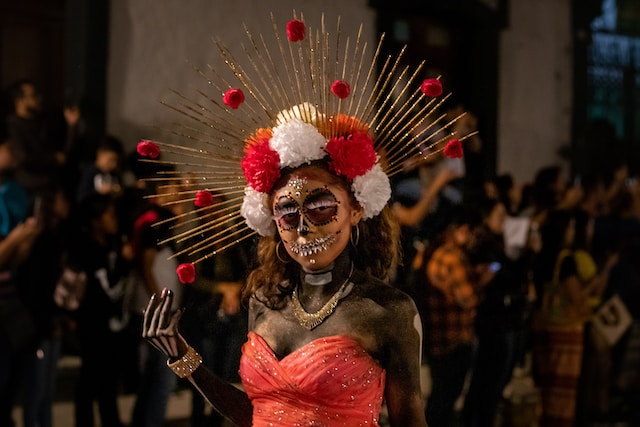
Experiencing Oaxaca City during Dia de los Muertos (Day of the Dead celebrations) offers a unique cultural odyssey. This vital Mexican cultural event awakens the city in a burst of color, music, and heartfelt emotion. Cemeteries become picturesque canvases dotted with marigolds and candles, while locals dress in ornate costumes and painted faces to honor the memory of their departed loved ones. Far more than a celebration, it’s a deeply moving display of Mexico’s intimate bond with mortality – a compelling reason for travelers to align their visit with this occasion.
Venturing into Oaxaca City is akin to unlocking a space where the past intertwines with the present, where time-honored traditions coexist with the rhythm of the modern world, and where every aspect of life is cherished. This capital city of the state of Oaxaca stands as a testament to the resilient character of Southern Mexico, laden with memorable experiences waiting to be unveiled. Whether it’s savoring the globally-acclaimed cuisine, delving into the historic center, or submerging oneself in local life, a journey to Oaxaca City is nothing less than a gift of memorable experiences.
So ready your luggage, make a drink with your favorite mezcal, and read this guide to let Oaxaca City welcome you into its captivating realm.
Table of Contents
Exploring the Historic Center
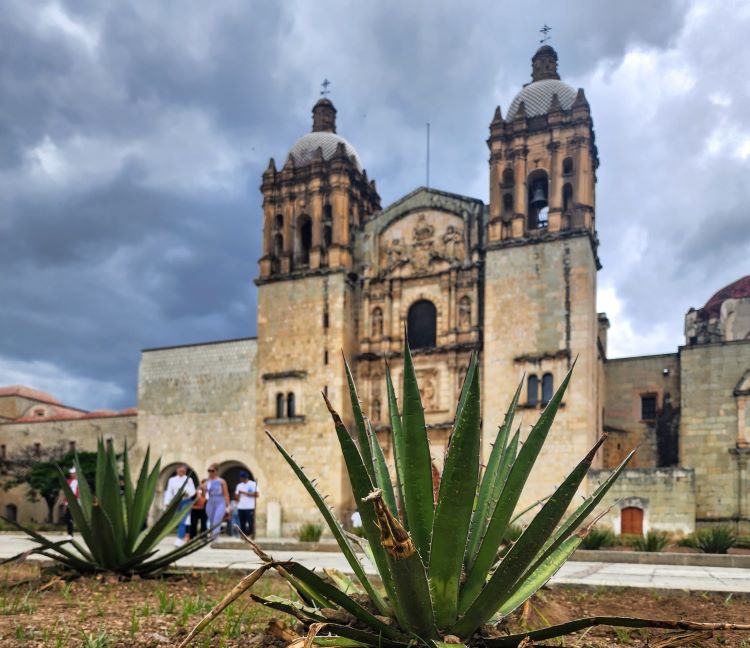
Oaxaca’s Historic City Center is like a living, breathing history book, where stories unfold on every corner. It’s a place where architectural styles, old and new, coexist harmoniously, with colonial buildings lending a sense of timelessness to the city. Strolling down its lanes, you’re bound to stumble upon landmarks and structures that whisper tales of the city’s evolution, notably the Templo de Santo Domingo and the Oaxaca Cathedral.
First up is the Templo de Santo Domingo, a gem nestled in the heart of Oaxaca City Center. You’d be hard-pressed to miss its ornate façade, a grand spectacle that reels you in. Santo Domingo Church, a tribute to the detailed Baroque architectural style of Mexico, took two centuries to be fully realized. And the Mexican military occupied its halls from 1860 all the way up to 1994 before finally returning it to the Dominicans. Its grandeur sweeps over you, and the inside is every bit as beautiful as the exterior, with intricately carved panels covered in gold leaf telling biblical tales. Walk its corridors, and you’ll feel like you’re journeying back in time, surrounded by stories etched into the very fabric of the church.
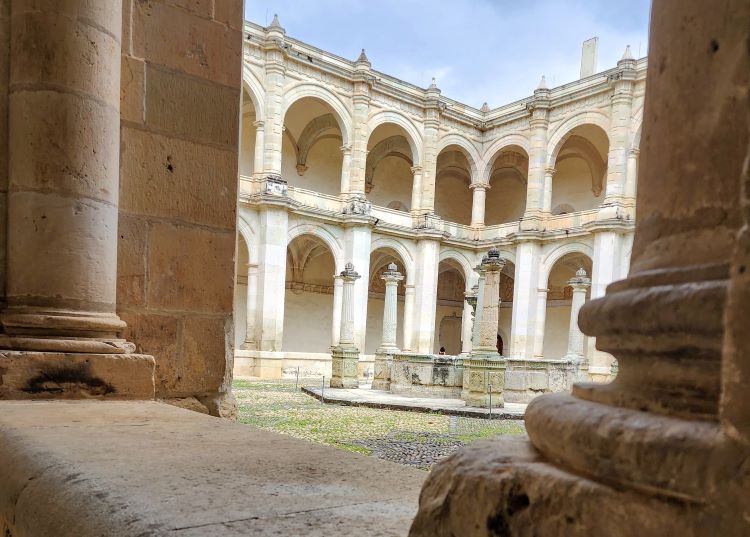
We hired a bilingual guide who was available just outside the entrance. He provided us with valuable insights into the architecture, the people who lived there as well as some of the more sordid details of the church’s history. I would highly recommend hiring a guide if you are hoping to get to know more about this beautiful site.
Just around the corner from Templo de Santo Domingo is another beacon of Oaxaca City’s history: the Oaxaca Cathedral. Renowned for its dramatic façade and towering bell towers, the cathedral stands tall, an impressive example of neoclassical architecture. Step inside and your gaze will instantly be drawn to the gorgeous altar, its centerpiece an image of the Virgin Mary.
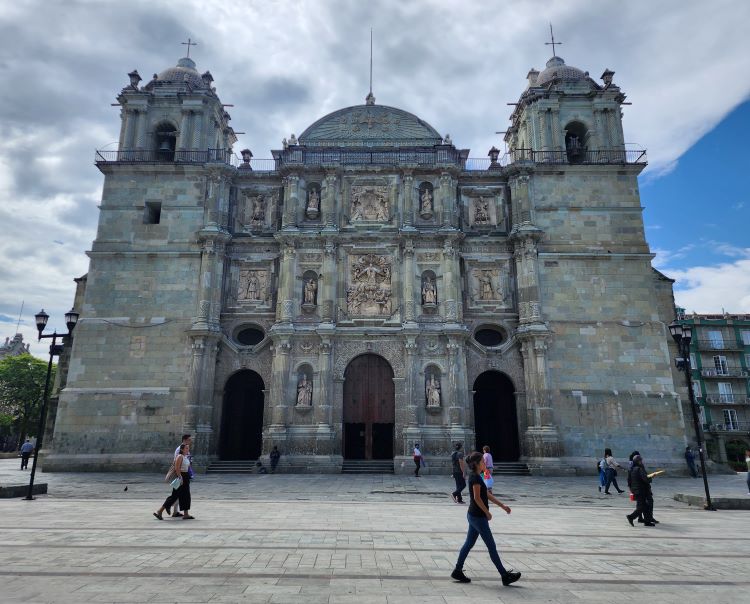
But the Templo de Santo Domingo and the Oaxaca Cathedral aren’t the only notable spots. As you wander through the city center, colonial buildings catch your eye, their striking colored façades proof of Oaxaca City’s evolving story over centuries.
And it’s not just the architectural sites that give life to Oaxaca City’s historic center. The city’s pulse is evident in its street art, where local artists have transformed walls and facades into vibrant canvases. These murals provide an exciting peek into the city’s ongoing narrative.
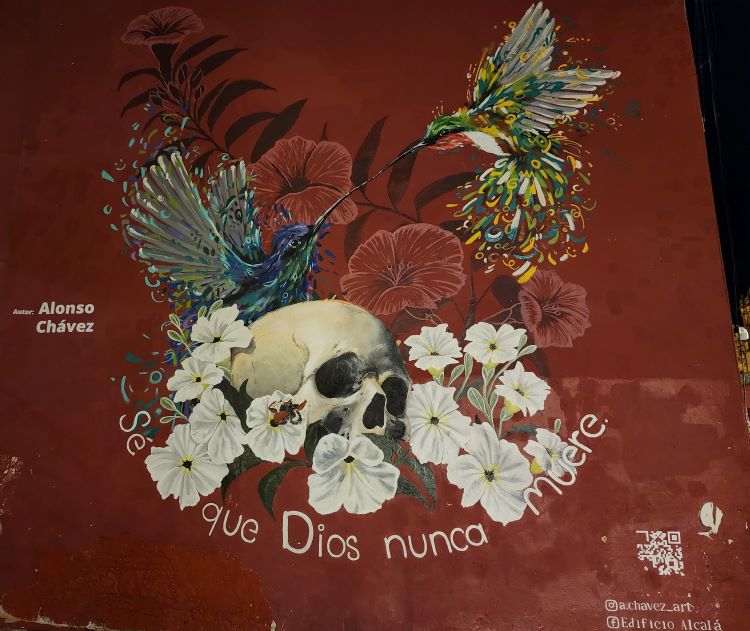
The cultural center, another important spot in the city center, is a hub of events and exhibitions celebrating Oaxaca’s heritage. Showcasing a mix of traditional and contemporary art forms, it offers an insightful look into the city’s creative spirit and cultural richness.
No exploration of the city center is complete without a visit to the Museo Textil de Oaxaca. A tribute to Oaxaca’s textile tradition and the world’s, this museum houses an impressive collection of fabrics and traditional looms. It’s a chance to dive deep into the art of textile making, like what you can see on a day trip to nearby Teotitlan del Valle, from local weaving techniques to global designs.
Oaxaca Historic City Center is much more than a cluster of historic buildings and landmarks. It’s a lively mix of the city’s past and present, where history and modernity intertwine. From the awe-inspiring Templo de Santo Domingo to the grand Oaxaca Cathedral, the charming colonial architecture, the lively street art, and the enriching Museo Textil de Oaxaca, the city center is a treasure waiting to be discovered at every corner. This immersive journey into Oaxaca City’s heart is sure to leave an indelible imprint on every traveler’s mind.
A Food Lover’s Paradise: Savoring the Gastronomic Delights of Oaxaca City
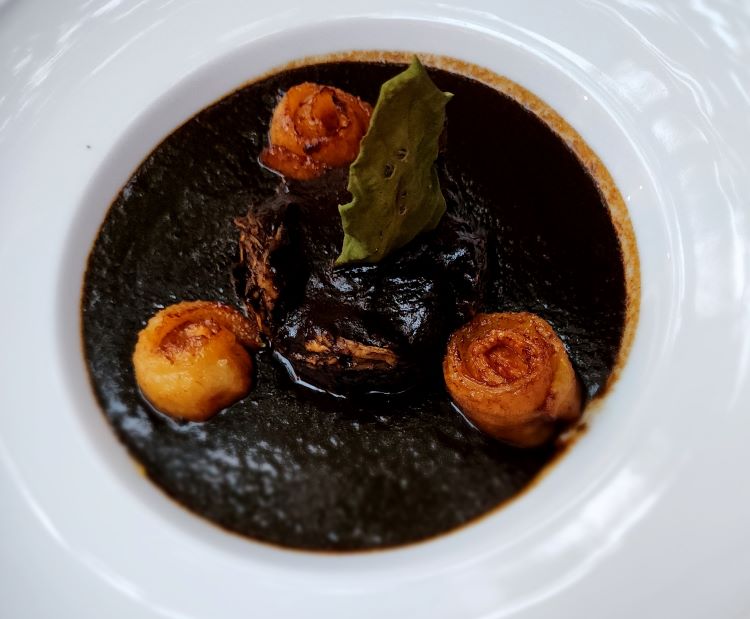
Oaxaca City, with its rich cultural tapestry, also boasts an equally diverse and fascinating culinary scene. Its local cuisine, a delightful mix of traditional dishes, delicious street food, and decadent hot chocolate, serves as a testament to the region’s profound history and vibrant lifestyle.
In Oaxaca City, food is more than just sustenance; it’s an experience. Traditional dishes offer a slice of the region’s history, packed with flavors that seem to tell their own tales. One must-try is mole, a complex and rich sauce with variations ranging from the chocolatey Mole Negro to the fresh and herbaceous Mole Verde. Typically served over chicken, pork or turkey, it’s a feast for the senses. Another beloved local dish is tlayudas, often dubbed as Mexican pizza, topped with beans, Oaxacan cheese (quesillo), meat, and a symphony of other ingredients.
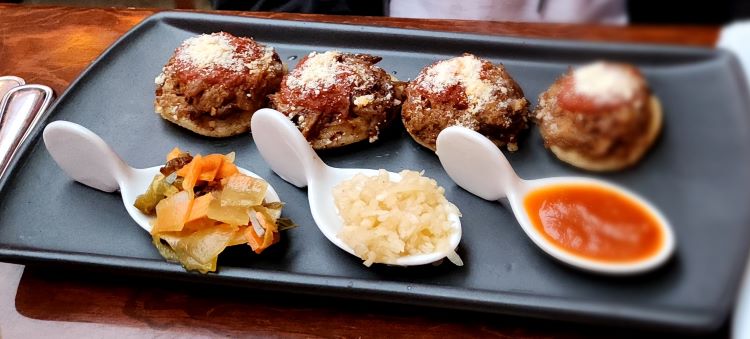
Street food in Oaxaca City is as diverse and rich as its traditional dishes. Street vendors serve everything from Tacos al Pastor (marinated pork tacos) to Elotes (corn on the cob), sprinkled with chili, lime, and cheese. Not to forget, the popular empanadas filled with a variety of ingredients like mole, mushrooms, or cheese.
And for those with a sweet tooth, Oaxaca’s hot chocolate is fantastic. Prepared traditionally with water or milk, chocolate tablets peppered with cinnamon are whisked to a frothy finish using a wooden tool called a “molinillo,” this sweet treat is perfect for starting your day or winding down after a food-filled adventure.
Get Your Travel Goals Newsletter & BONUS Workbook
While the food in Oaxaca is second to none, the experience of exploring local markets elevates it to another level. Mercado Benito Juárez is perhaps the most popular market in the city. Buzzing with activity, this market is a fantastic place to sample local food, pick up souvenirs, and witness both tourist and local life together. You can find everything from Oaxacan cheese and local mezcal to colorful handwoven textiles.
However, for the ultimate market experience, the Mercado Central de Abastos outdoes all others. The largest market spanning over 800 acres, it’s a sprawling labyrinth of stalls selling fresh produce and local goods. From exotic fruits, unique local herbs, and handmade tortillas to beautiful handicrafts, it’s a sight to behold and a sensory delight. You will get lost here I promise you but enjoy the unique discoveries around each corner and don’t be afraid to practice your Spanish and ask for directions!
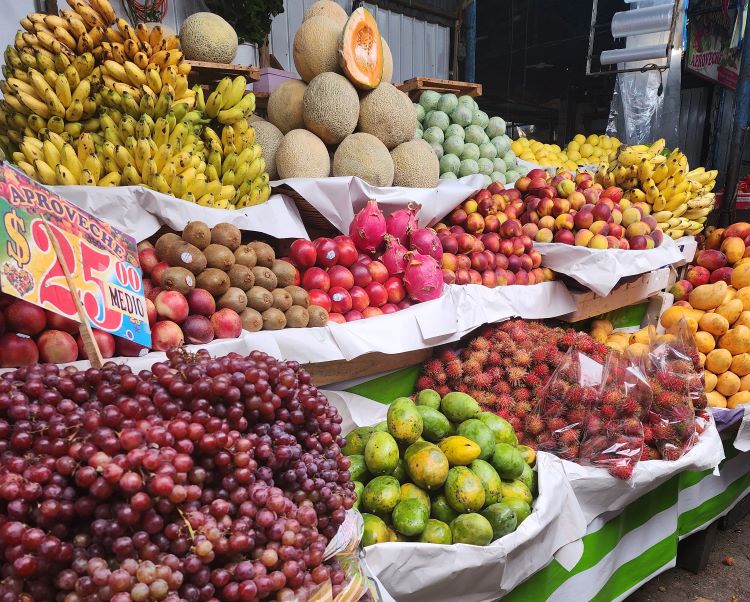
Mercado 20 de Noviembre, another remarkable food market just south of Benito Juarez market, is a haven for meat lovers. Known for its grilled meats section, this market offers a carnivorous adventure that’s sure to satisfy. Choose your meat, and watch as it’s cooked to perfection on an open grill.
To round off your gastronomic journey, there are numerous restaurants in Oaxaca City that offer a refined dining experience. From local fare to fusion cuisine, these eateries showcase the best of Oaxacan gastronomy. A few notable mentions are Los Danzantes, for their contemporary Oaxacan meals complemented by flights of mezcal, Quince Letras for its service and high-quality dishes, and Restaurante Catedral, known for its culinary creativity and exceptional flavors.
Half the joy of a visit to Oaxaca City lies in its local cuisine, traditional dishes, and delectable street food, which are abundant in its markets and restaurants that contribute to the city’s dynamic food scene. The activity of Mercado Benito Juárez, the size, and diversity of Mercado Central de Abastos, the mouthwatering grills of Mercado 20 de Noviembre, and the curated culinary delights of its best restaurants all make Oaxaca a true food lover’s paradise.
Because we are affiliated with products we believe in if you click on a link, find something that rings your bells, and get it, that means we get a small fee at no additional cost to you.
Day Trips from Oaxaca City: Exploring Beyond the City Limits
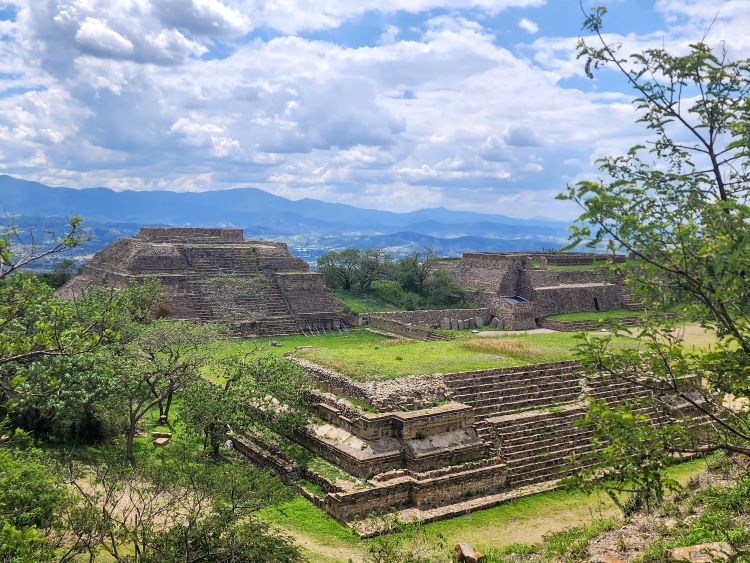
While Oaxaca City is packed with charm and history, venturing a little further out offers a whole new set of wonderful experiences. From ancient ruins to mesmerizing natural wonders, the surrounding areas hold their own allure and make for great day trips. We rented a car in the historic center and used DiscoverCars to find the absolute best price. This gave us the freedom we wanted to explore the surrounding areas independently.
Firstly, Monte Albán is an absolute must-visit. As one of the earliest cities of Mesoamerica, this UNESCO World Heritage Site offers a fascinating glimpse into the ancient Zapotec civilization. Its extensive complex of pyramids, tombs, and temples standing atop a flattened hill is a sight to behold. You can easily reach Monte Albán by public transport or a rental car; it’s just a short 20-minute drive from Oaxaca City. When we visited there was someone to show us where to park and guide us to the entrance. Otherwise, we had the grounds to ourselves. So if you are looking for a less crowded experience with Mexico’s ancient ruins this location will definitely appeal to you. You can read our entire post on everything you need to know to take this day trip to Monte Alban and more!
If ancient ruins pique your interest, then a visit to Mitla should also be high on your list. Unlike the grand pyramids of Monte Albán, Mitla showcases intricate geometric mosaics and is considered to be the most important Zapotec site for religious ceremonies. Mitla is about a 40-minute drive from Oaxaca City, and the journey can be made by public transport or a rental car.
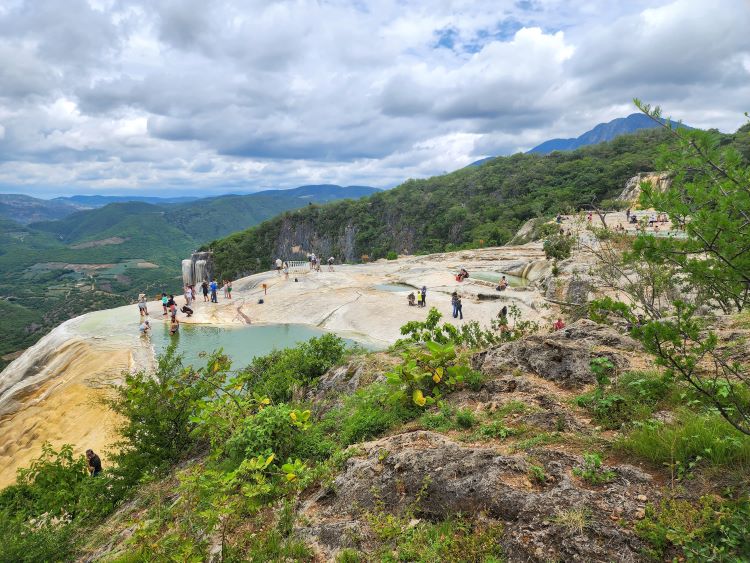
Just beyond Mitla, nature lovers will delight in Hierve el Agua, a unique natural wonder that resembles cascading waterfalls but is, in fact, rock formations created over thousands of years by mineral-rich water. This geological phenomenon offers a unique, albeit sometimes crowded, backdrop for photos and a fantastic spot for a leisurely dip in the natural pools. You can reach Hierve el Agua by a collective taxi (colectivo) from Oaxaca City, which takes about an hour and a half, or by rental car. Be aware that you will get there a bit quicker by paying to drive on the toll road 96 pesos per car and you’ll pay locals 50 pesos per person to take the road toward the site and then 20 pesos per person to enter the site and park. You can read our entire post on a day trip that combines a visit to Hierve el Agua and Mitla and more.
Next on the list is Teotitlán del Valle, a village renowned for its generations-old tradition of weaving. Here, local artisans transform wool into beautiful rugs using ancient techniques. You can witness the process from start to finish and perhaps take home a handmade piece. Teotitlán del Valle is about a 30-minute drive from Oaxaca City and can be accessed by public transport or a rental car. You can read our entire post on Teotitlan del Valle including where to go to have the most authentically engaging experience.
Lastly, make sure to visit San Bartolo Coyotepec, famed for its stunning black pottery known as Barro Negro. You can watch artisans as they meticulously shape, polish, and fire the clay to create beautiful and intricate designs. San Bartolo Coyotepec is just 15 kilometers south of Oaxaca City and is accessible by public transport or car.
Get Your Travel Goals Newsletter & BONUS Workbook
Given the distance of these destinations from Oaxaca City, renting a car is a practical option for those who prefer the freedom to explore at their own pace. Websites like DiscoverCars.com offer a great platform to compare prices and find the perfect vehicle to suit your needs.
Each of these spots, from the ancient magnificence of Monte Albán and Mitla to the natural beauty of Hierve el Agua, and the rich artisan traditions of Teotitlán del Valle and San Bartolo Coyotepec, offers a unique glimpse into the diverse tapestry that is Oaxaca. So, take a day trip or two, and uncover the many treasures waiting just beyond the city limits.
The Art of Mezcal Tasting: Oaxaca’s Liquid Gold
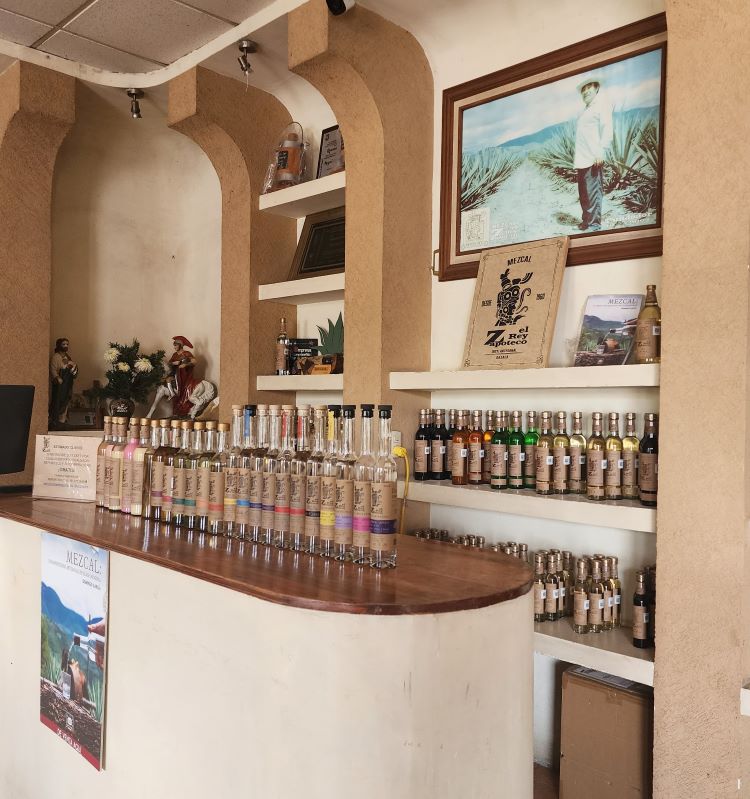
If Oaxaca has a rhythm, it moves to the rhythm of mezcal. This distinctive, smoky spirit is an integral part of Oaxaca’s cultural identity and holds a special place in the hearts of locals and visitors alike. If you’ve tried mezcal elsewhere, trust me you need to try it here. A mezcal tasting or tour offers an immersive experience of the rich history, production, and diverse flavors of this renowned spirit.
Mezcal production is a labor of love, a process steeped in tradition and patience, starting with the cultivation of agave plants. These hardy, spikey plants, with their varied shapes and sizes, dominate the Oaxacan landscape. There are several varieties of agave, each imparting a distinct flavor profile to the mezcal it produces. Espadín is the most common variety used, but other types such as Tobalá, Madrecuixe, and Tepeztate are also popular.
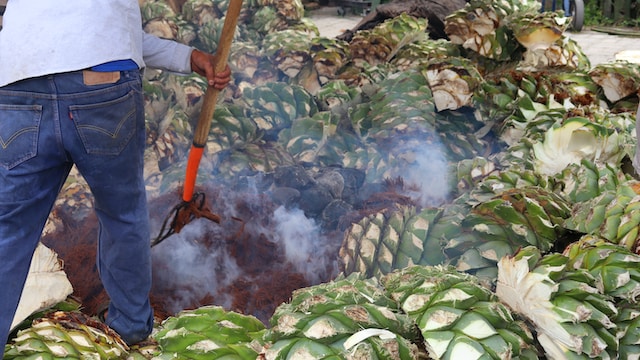
The life of an agave plant is slow and steady, with some varieties taking up to 25 years to reach maturity. When ready, the plants are harvested, and the heart or “piña” is extracted. These piñas are then cooked in an underground pit, a process that imparts the signature smoky flavor to a mezcal. The cooked agave is crushed, usually by a large stone wheel pulled by a horse or a donkey, and then fermented and distilled.
To truly appreciate the complexity of mezcal, a tasting is highly recommended. Expert-led mezcal tastings provide an understanding of the factors influencing its flavors, such as the variety of agave used, the region where it’s grown, the distillation process, and the aging period. Just like wine, mezcal tasting involves sight, smell, and taste. Look at its clarity, inhale its rich aromas, and savor its diverse flavors. From smoky to fruity, earthy to floral, every sip tells a story.
Get Your Travel Goals Newsletter & BONUS Workbook
For a more hands-on experience, consider embarking on a mezcal tour. This is a journey that takes you out of the city and into the rural areas where mezcal production takes place. You’ll visit palenques (small, traditional mezcal distilleries), meet maestro mezcaleros (master mezcal makers), and see firsthand the process from agave plant to bottled spirit. Some tours even offer the chance to participate in the production, like assisting in the harvest or the distillation process.
There are numerous mezcalerias in Oaxaca City offering tastings and several tour operators who can take you on a mezcal expedition. From high-end tasting rooms offering a wide range of artisanal mezcal to small, rustic palenques where the spirit is produced, there’s an experience to match every preference. Since we had a rental car and were taking day trips we stopped in the town of Santiago Matatlan, called the mezcal making capital of the world. Driving down the main street you will see numerous stores that sell mezcal and distilleries that offer tours. We stopped at El Rey Zapoteco.
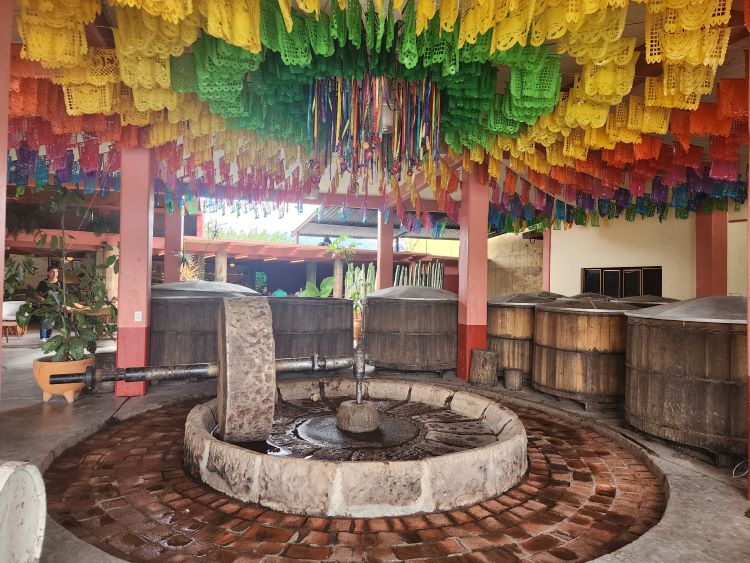
At the time of our visit, they charged 100 pesos per person to take a tour of the facilities and learn about the mezcal-making process. They have a lively tasting room and a dining area. I highly recommend the shrimp tacos and a plate of guacamole with chips. You can, of course, order drinks from their bar as well.
In essence, mezcal tasting in Oaxaca is more than just savoring a drink; it’s an exploration of culture, tradition, and craft. It’s about understanding and appreciating the time, effort, and passion that goes into every bottle. From the slow-growing agave plants to the traditional production methods, every aspect contributes to the unique character of Oaxaca’s beloved spirit. Whether you embark on a mezcal tour or participate in a local tasting, you’ll leave with a deeper connection to Oaxaca and a newfound appreciation for its liquid gold.
Local Markets and Shopping: Unearthing Oaxaca’s Artisanal Riches
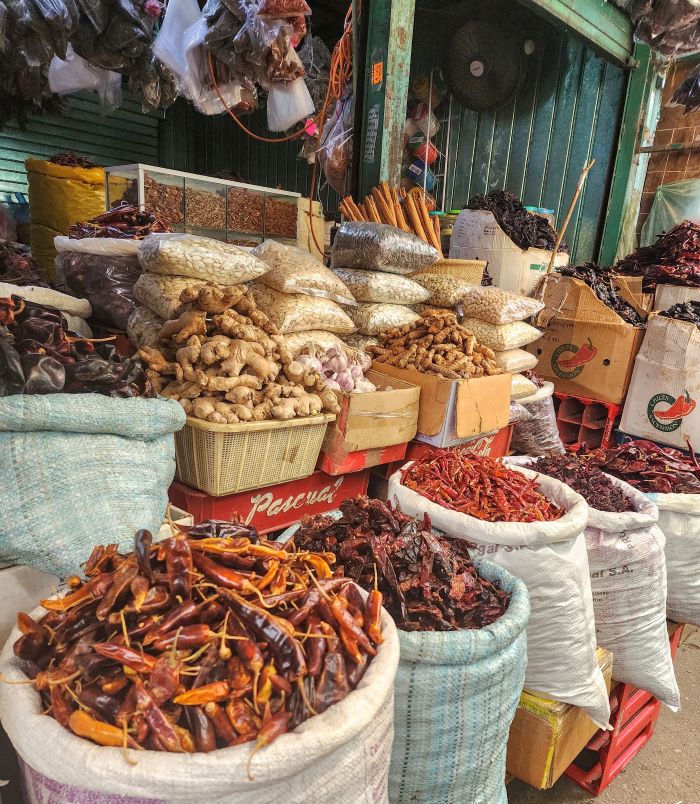
If you’re seeking a close encounter with Oaxaca’s artistry, your journey must include an exploration of the valley’s local markets and shops. Bursting with energy, colors, and an array of products, these bustling hubs are essential destinations for those looking to take home a slice of Oaxaca’s rich cultural tapestry.
Stepping into a local market in the Oaxaca area is like stepping into a kaleidoscope of sights, sounds, and smells. Here, amid the hum of conversations and the clatter of commerce, you’ll find street vendors proudly showcasing their wares. From fresh, aromatic produce to handcrafted jewelry, every stall and shop is a mini showcase of Oaxaca’s bounty.
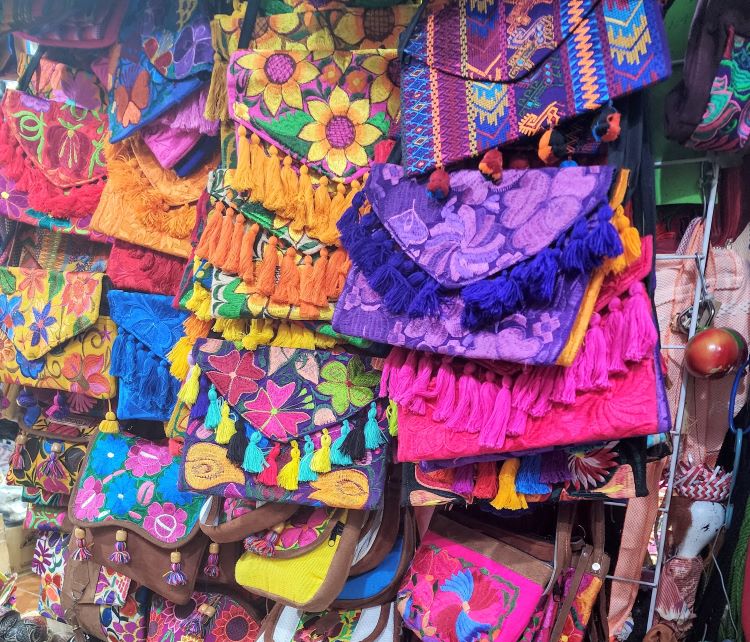
However, it is the traditional clothing and wool that often draws the most attention. Garments are not just items of clothing, but wearable pieces of art. They’re imbued with generations of skill and tradition, and each piece tells a story. Whether it’s a handwoven rug, a beautifully embroidered blouse, or a carefully crafted piece of pottery, these items bear the mark of the artisans who poured their time and talent into creating them.
Now, where to find these treasures? Let’s start with Arrazola, a small town that has made a big name for itself in the world of alebrijes. These fantastical, brightly painted wooden creatures are the stuff of dreams (quite literally the original artist painted paper mache creatures that had appeared to him in a dream) and make for an eye-catching addition to any home decor. A stroll through Arrazola will lead you to workshops and stores brimming with these unique pieces, each one more intricate and colorful than the last. But we recommend you stop at Casa Museo Don Manuel Jiminez to see these figurines at their best. The artist himself will show you around and the pieces, all painted by him his wife, or his daughters, are available for you to purchase. They also hold classes for students who would like to dive a bit deeper into creating alebrijes of their own.
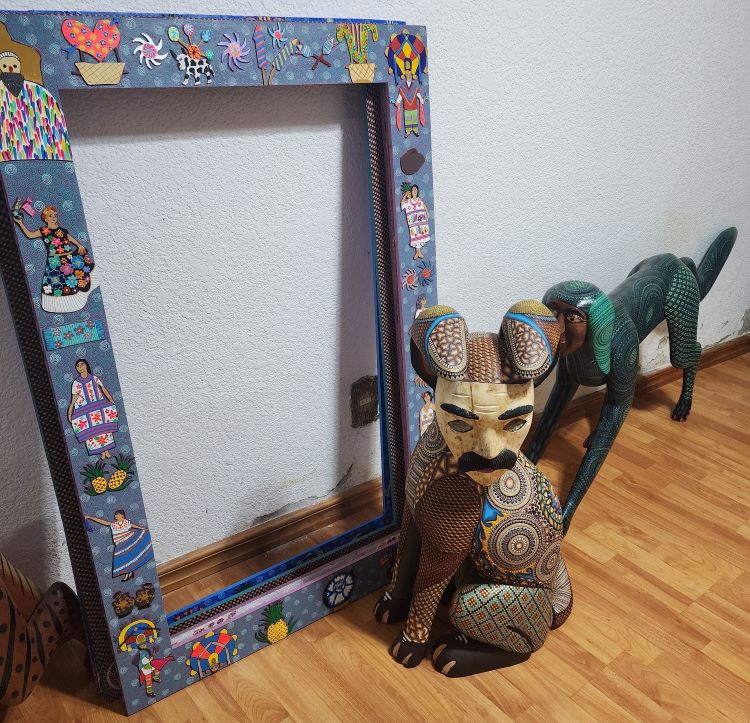
If ceramics are more your style, a trip to Santa Maria de Atzompa should be on your itinerary. Known for its green-glazed pottery, this town is a hub of ceramic artistry. Local artisans open their workshops to visitors, providing a chance to see the artisans in action and perhaps even try your hand at the craft. Whether you’re looking for a decorative item or a functional piece of pottery, you’re sure to find something that catches your eye.
For lovers of textiles, the town of San Antonio Castillo Velasco is a must-visit. Renowned for its mipil – blouses adorned with intricate embroidery – this town is a paradise for anyone interested in traditional clothing. The mipil, with its vibrant colors and exquisite detailing, is an expression of the town’s heritage and an example of the high-quality craftsmanship Oaxaca is known for.
Get Your Travel Goals Newsletter & BONUS Workbook
As you journey through Oaxaca’s towns and markets, remember that each purchase supports local artisans and their families. So whether you’re discussing prices with street vendors, exploring traditional clothing shops, or visiting your favorite local spots, you’re not just shopping. You’re participating in a long-standing tradition of craftsmanship and commerce, becoming part of Oaxaca’s rich cultural narrative while finding some beautiful pieces to bring back home. Please consider the time and commitment these pieces take to create and be respectful when reflecting on prices. This way, your travel memories will be stitched, molded, and carved into tangible keepsakes, connecting you to Oaxaca and supporting local artisans long after your visit has ended.
Cultural Experiences: Delving Deep into Oaxaca’s Rich Tapestry
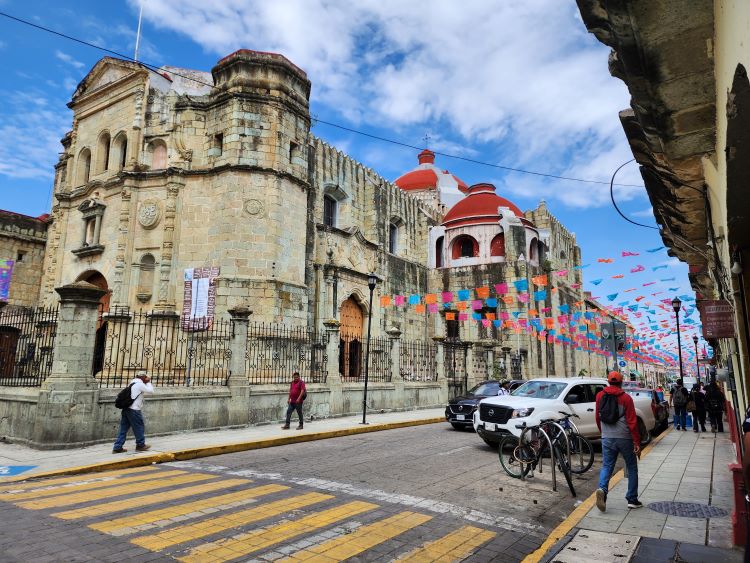
Unfolding the layers of Oaxaca’s rich cultural identity offers travelers a multitude of profound and authentic experiences. The essence of this region stems from its deeply-rooted indigenous culture, a blend of distinct traditions and languages that together form a diverse cultural mosaic.
Oaxaca, with its 16 officially recognized indigenous groups, is an area of remarkable linguistic diversity. Numerous languages and dialects are spoken here, each carrying a unique cadence that encapsulates the region’s heritage. Participating in local conversations, even if just as a listener, allows visitors a unique insight into this rich linguistic landscape.
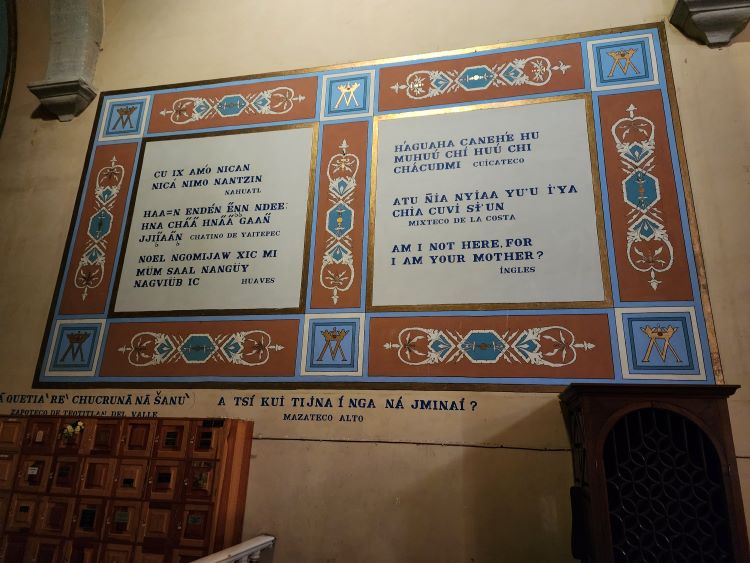
The opportunity to engage with local people and immerse oneself in their daily routines is a truly transformative experience. Their warm hospitality and rich storytelling are invitations to learn about their history, traditions, and ways of life. Whether you’re sharing a meal, participating in a local festivity, or simply engaging in a warm, friendly chat, each encounter provides a fresh perspective on Oaxaca’s rich cultural fabric.
One distinctive way to connect with Oaxaca’s ancestral traditions is through a Temazcal ceremony. This ancient ritual, which originated with indigenous Mesoamerican cultures, is a therapeutic experience that combines heat, herbs, and meditation. Stepping into a Temazcal – a dome-shaped structure – involves entering a symbolic womb, a space for purification and rebirth. Experiencing this ceremony under the guidance of a local healer is a deeply spiritual journey that offers insight into the indigenous cultural practices of health and wellbeing.
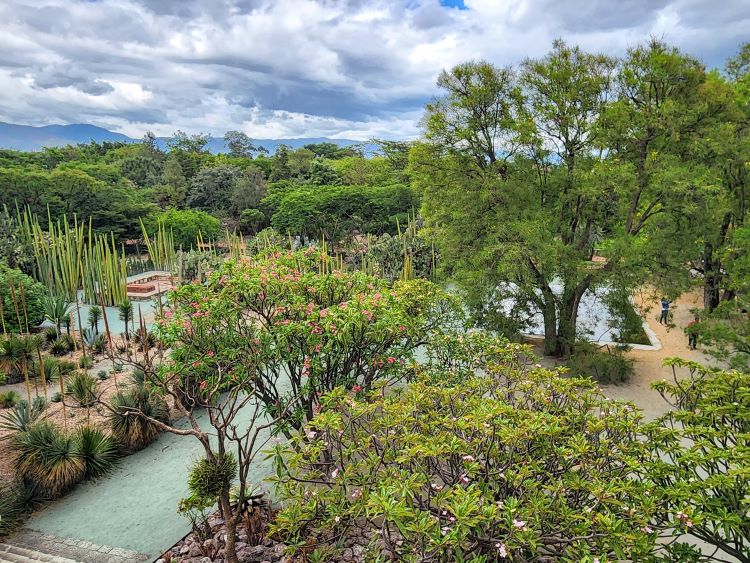
Oaxaca is also home to numerous cultural landmarks that encapsulate the region’s rich history and biodiversity. One such treasure is the Jardin Etnobotanico de Oaxaca. More than just a botanical garden, it is a tribute to the intricate relationships between the indigenous communities and their natural environment. Wandering through this garden, visitors encounter an impressive array of plant species native to Oaxaca, many of which play pivotal roles in the region’s ecological, cultural, and economic life.
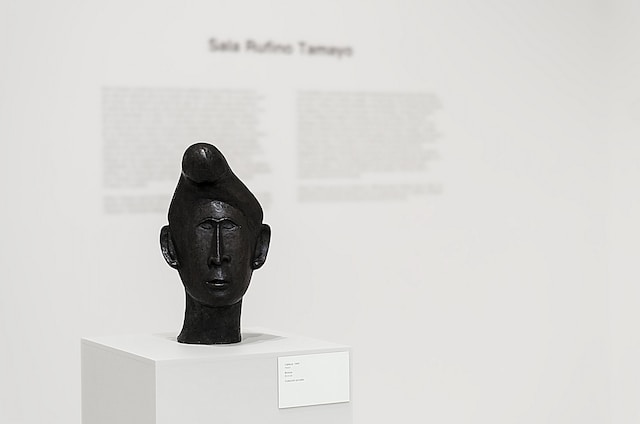
Equally captivating is the Rufino Tamayo Museum, which houses an extensive collection of pre-Hispanic art. The museum, named after the famous Oaxacan painter Rufino Tamayo, offers a deep dive into the region’s pre-Columbian past. The displayed artifacts – spanning from pottery to sculpture – narrate silent yet profound stories of civilizations that shaped Oaxaca’s cultural heritage.
Exploring Oaxaca is a journey of discovery, where each experience – whether it’s participating in a traditional Temazcal ceremony, conversing with the local people, exploring the Jardin Etnobotanico de Oaxaca, or appreciating the artifacts in the Rufino Tamayo Museum – offers a deeper connection with the region’s indigenous culture. As you delve into the depth of these experiences, you’ll find Oaxaca unfolding its narrative in a myriad of vibrant cultural hues, inviting you to immerse yourself in its rich and enduring heritage.
Festivals and Events: Oaxaca’s Cultural Celebrations
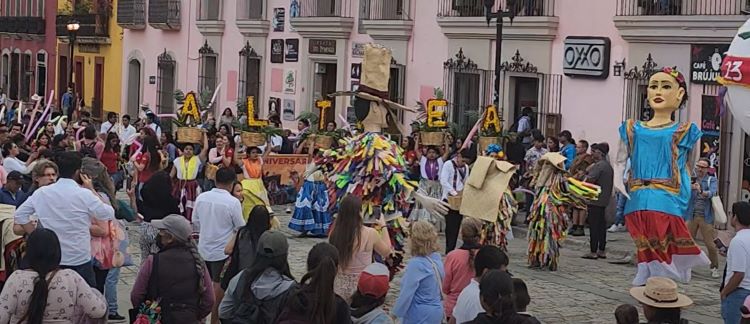
Celebrations are an integral part of Oaxaca’s cultural tapestry, and the city hosts several festivals throughout the year that bear testament to this. They provide an incredible window into Oaxacan culture, filled with vivid colors, lively music, delectable cuisine, and warm camaraderie.
Undoubtedly, one of the most significant events is Dia de los Muertos or Day of the Dead. This celebration, a blend of ancient Mesoamerican beliefs and Catholicism, sees families gather to honor their loved ones who have passed on. Colorful altars known as “ofrendas” are adorned with flowers, candles, photographs, and the deceased’s favorite foods. The air is filled with the scent of marigold petals and copal incense, leading the spirits back home for a night of joyful remembrance. The event also sees parades, concerts, and traditional dances, turning the city into a vibrant spectacle of respect and fond memories.
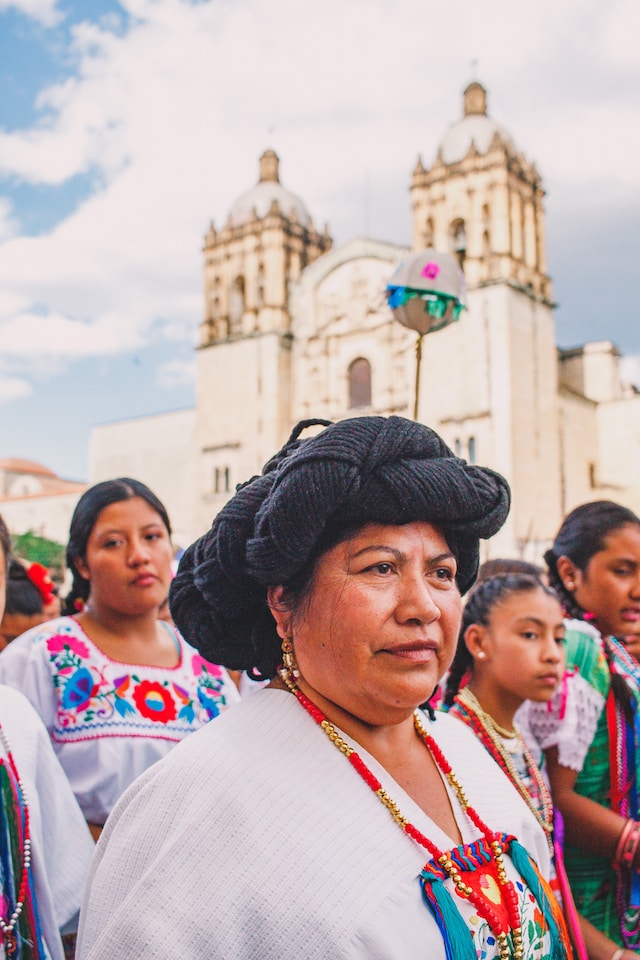
Another highly anticipated event is the Guelaguetza Festival. This celebration of indigenous cultures showcases traditional dances, music, and costumes from the many ethnic communities of Oaxaca. Spectators are treated to a breathtaking display of color and rhythm as each group proudly performs their ancestral dances. This festival also offers an opportunity to taste regional cuisines, witness traditional weaving demonstrations, and purchase unique handicrafts, encapsulating the rich diversity of Oaxaca.
The Oaxaca Mezcal Festival, also known as Mezcal Week, is a testament to the region’s love for this iconic spirit. The festival brings together mezcal producers, bartenders, and enthusiasts for a week of tastings, workshops, and lively celebrations. It’s an excellent opportunity for visitors to learn about the production process and experience the distinct flavors of mezcal.
Get Your Travel Goals Newsletter & BONUS Workbook
Finally, there is Benito Juarez Day, a national holiday observed in honor of Benito Juarez, a beloved figure in Mexican history and a native of Oaxaca. Juarez, a Zapotec from Oaxaca, rose from humble beginnings to become one of Mexico’s most revered presidents, known for championing indigenous rights and national sovereignty. To Oaxacans, Juarez is not just a historical figure but a symbol of resilience and perseverance. Celebrations on this day include parades, speeches, and ceremonies held at monuments dedicated to Juarez.
These events and festivals in Oaxaca offer more than just entertainment; they provide visitors with a genuine insight into the region’s cultural ethos. Participating in Dia de los Muertos, the Guelaguetza Festival, Oaxaca Mezcal Festival, or Benito Juarez Day celebrations allows visitors to truly connect with Oaxaca’s unique spirit, enhancing their travel experience in remarkable ways.
Oaxaca, A Cultural Tapestry Unrivaled
The enchanting city of Oaxaca, nestled in the heart of southern Mexico, offers an immersive journey into the cultural heritage of Latin America. With a richness and depth that outshines even popular destinations like Mexico City, Tulum, and Chichen Itza, Oaxaca provides an intimate, unrushed exploration of Mexico’s indigenous roots, historic splendors, culinary delights, and vibrant local culture.
From its captivating historic center with its majestic Templo de Santo Domingo and Oaxaca Cathedral to the local marketplaces bustling with traditional crafts and flavors, Oaxaca City invites travelers to take part in its living history. Every turn and twist in its cobblestone streets, every sip of its traditional hot chocolate, every gaze upon the intricate street art, echoes the symphony of its rich heritage and the warmth of its people.
Get Your Travel Goals Newsletter & BONUS Workbook
Visiting the city and its surrounding small towns offers unique experiences. Discover the ancient ruins at Monte Alban and Mitla, marvel at the natural beauty of Hierve el Agua, or meet the traditional weavers of Teotitlán del Valle. The excitement of choosing a unique alebrije in Arrazola, finding the perfect mipil in San Antonio Castillo Velasco, or even admiring the pottery in Santa Maria de Atzompa, can only be described as uniquely Oaxacan.
Savoring the local cuisine, from the delectable street food to traditional dishes at the city’s best restaurants, is an adventure in itself. The food markets like Mercado Benito Juárez, Mercado 20 de Noviembre, and the vast Mercado Central de Abastos offer a cornucopia of flavors that have to be tasted to be believed.
Mezcal tasting, a quintessential Oaxacan experience, allows you to delve into the complexities of this beloved spirit, offering an appreciation of the meticulous craft that goes into each bottle.
Beyond the sights and tastes, Oaxaca provides opportunities for deeply personal cultural experiences. Engage with the indigenous culture, take part in a Temazcal ceremony, visit the Jardin Etnobotanico de Oaxaca or the Rufino Tamayo museum, and immerse yourself in the region’s pulsating heart.
The city’s calendar is also dotted with vibrant festivals that capture its spirit and vitality. Whether it’s the profound remembrance during Dia de los Muertos, the colorful display of culture during the Guelaguetza Festival, the lively celebration of Oaxaca’s favorite spirit during Mezcal Week, or the heartfelt homage to Benito Juarez, each event provides a window into the Oaxacan soul.
To sum it all up, here’s a list of the top things to do in Oaxaca City:
- Explore the historic center with its notable architectural marvels.
- Savor the local cuisine and take a mezcal tour.
- Visit the local markets and discover the rich tapestry of traditional crafts.
- Take a day trip to explore surrounding towns and natural wonders.
- Immerse yourself in cultural experiences that reveal the indigenous heart of the region.
- Take part in the city’s vibrant festivals and events.
In the end, Oaxaca City is more than just a destination; it’s a sensory journey that leaves lasting impressions. So, dear reader, take the plunge. Step off the beaten path and experience the authentic charm of Oaxaca. This small city, with its vibrant culture, history, and warmth, awaits to welcome you into its beautiful fold.
